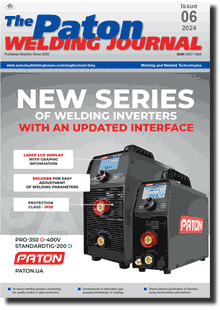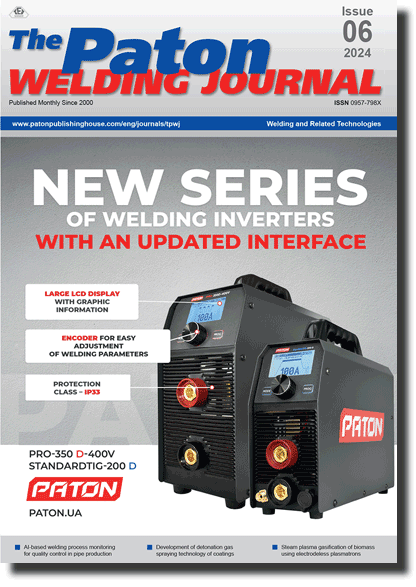| 2024 №06 (06) |
DOI of Article 10.37434/tpwj2024.06.01 |
2024 №06 (02) |

The Paton Welding Journal, 2024, #6, 3-8 pages
Application of AI-based welding process monitoring for quality control in pipe production
S. Gook1, B. El-Sari1, M. Biegler1, M. Rethmeier2,1,3
1Fraunhofer Institute for Production Systems and Design Technology IPK, Berlin, Germany. E-mail: sergej.gook@ipk.fraunhofer.de2Chair of Joining, Technische Universität Berlin, Germany
3Bundesanstalt für Materialforschung und -Prüfung (BAM), Berlin, Germany
Abstract
The paper presents the experimental results into the development of a multi-channel system for monitoring and quality assurance of the multi-wire submerged arc welding (SAW) process for the manufacture of large diameter pipes. Process signals such as welding current, arc voltage and the acoustic signal emitted from the weld zone are recorded and processed to provide information on the stability of the welding process. It was shown by the experiments that the acoustic pattern of the SAW process in a frequency range between 30 Hz and 2.5 kHz contains the most diagnostic information. The on-line quality assessment of the weld seam produced is carried out in combination with methods of artificial intelligence (AI). From the results obtained, it can be concluded that the use of the latest concepts in welding and automation technology, combined with the high potential of AI, can achieve a new level of quality assurance in pipe manufacturing.
Keywords: submerged arc welding, high-strength fine-grain steels, pipe production, artificial intelligence, acoustic signals, quality control
Received: 23.05.2024
Received in revised form: 26.06.2024
Accepted: 29.07.2024
References
1. Brensing, K.H., Sommer, B. Herstellverfahren für Stahlrohre. Salzgitter Großrohre GmbH. www.wv-stahlrohre.de/fileadmin/pdf/Stahlrohre_Herstellverfahren.pdf2. Moeinifar, S., Kokabi, A.H., Hosseini, H.M. (2011) Role of tandem submerged arc welding thermal cycles on properties of the heat affected zone in X80 microalloyed pipe line steel. J. of Materials Processing Technology, 211(3), 368-375 https://doi.org/10.1016/j.jmatprotec.2010.10.011
3. Feinberg, L.J., Shchegol, V.V., Honcharenko, L.V. (2022) Two-wire submerged-arc welding with cold wire application. The Paton Welding J., 1, 3-8. https://doi.org/10.37434/tpwj2022.01.01
4. Hochhauser, D.I.F., Rauch, M.R. (2012) Influence of the soft zone on the strength of welded modern HSLA steels. Welding in the World, 56(5-6), 77-85. https://doi.org/10.1007/BF03321352
5. Layus, P., Kah, P., Martikainen, J. et al. (2014) Multi-wire SAW of 640 MPa arctic shipbuilding steel plates. Inter. J. Adv. Manuf. Technol., 75(5-8), 771-782. https://doi.org/10.1007/s00170-014-6147-2
6. Hölbling, W. (2018) TM-Bleche im Extremeinsatz: Schweißen thermomechanisch gewalzter Bleche (TM-Bleche) für Offshore-Gründungen. Der Praktiker, Ausgabe 4.
7. Barot, R.S., Patel, V.J. (2021) Process monitoring and internet of things feasibility for submerged arc welding: State of art. Materials Today: Proc., 45, 4441-4446. https://doi.org/10.1016/j.matpr.2020.12.782
8. Neidel, A., Riesenbeck, S., Giller, M. (2022) Excessive lack of fusion in welds of limited accessibility. Practical Metallography, 59(3), 164-173. https://doi.org/10.1515/pm-2022-0015
9. Benakis, M., Du, C., Patran, A., French, R. (2019) Welding process monitoring applications and industry 4.0. In: Proc. of 15th Inter. Conf. on Automation Science and Engineering, August, 2019, 1755-1760. https://doi.org/10.1109/COASE.2019.8843319
10. Huot, P. (2015) The basics of weld and process monitoring. Quality, 6NDT.
11. Cheng, Y., Yu, R., Zhou, Q. et al. (2021) Real-time sensing of gas metal arc welding process - A literature review and analysis. J. of Manufacturing Processes, 70, 452-469. https://doi.org/10.1016/j.jmapro.2021.08.058
12. Chen, C., Lv, N., Chen, S. (2018) Data-driven welding expert system structure based on internet of things. Transact. on Intelligent Welding Manufacturing, I(3), 45-60). https://doi.org/10.1007/978-981-10-8330-3_3
13. Wang, B., Hu, S.J., Sun, L., Freiheit, T. (2020) Intelligent welding system technologies: State-of-the-art review and perspectives. J. of Manufacturing Systems, 56, 373-91. https://doi.org/10.1016/j.jmsy.2020.06.020
14. Gyasi, E.A., Handroos, H., Kah, P. (2019) Survey on artificial intelligence (AI) applied in welding: A future scenario of the influence of AI on technological, economic, educational and social changes. Procedia Manufacturing, 38, 702-714. https://doi.org/10.1016/j.promfg.2020.01.095
15. Panda, B.N., Babhubalendruni, M.V.A.R., Biswal, B.B., Rajput, D.S. (2015) Application of artificial intelligence methods to spot welding of commercial aluminum sheets (B.S. 1050). In: Proc. of Fourth Inter. Conf. on Soft Computing for Problem Solving, New Delhi 2015. Eds by K.N. Das, K. Deep, M. Pant et al. https://doi.org/10.1007/978-81-322-2217-0_3
16. Ahmed, F., Kim, K.-Y. (2017) Data-driven weld nugget width prediction with decision tree algorithm. Procedia Manufacturing, 10, 1009-19. https://doi.org/10.1016/j.promfg.2017.07.092
17. Wietrzniok, H., Lichtenthäler, F. (2014) Moderne Großrohrfertigung - Neue Hochleistungs-, Schweißstromquelle für alle Lichtbogenschweißverfahren, DVS Berichte, Band 306, 19-25, DVS-Verlag, Düsseldorf.
18. Subhash, S., Srivatsa, P.N., Siddesh, S. et al. (2020) Artificial intelligence-based voice assistant. In: Proc. of Fourth World Conf. on Smart Trends in Systems, Security and Sustainability (WorldS4), July, 2020, 593-596. https://doi.org/10.1109/WorldS450073.2020.9210344
Suggested Citation
S. Gook, B. El-Sari, M. Biegler, M. Rethmeier (2024) Application of AI-based welding process monitoring for quality control in pipe production. The Paton Welding J., 06, 3-8.The cost of subscription/purchase order journals or individual articles
| Journal/Currency | Annual Set | 1 issue printed |
1 issue |
one article |
| TPWJ/USD | 384 $ | 32 $ | 26 $ | 13 $ |
| TPWJ/EUR | 348 € | 29 € | 24 € | 12 € |
| TPWJ/UAH | 7200 UAH | 600 UAH | 600 UAH | 280 UAH |
| AS/UAH | 1800 UAH | 300 UAH | 300 UAH | 150 UAH |
| AS/USD | 192 $ | 32 $ | 26 $ | 13 $ |
| AS/EUR | 180 € | 30 € | 25 € | 12 € |
| SEM/UAH | 1200 UAH | 300 UAH | 300 UAH | 150 UAH |
| SEM/USD | 128 $ | 32 $ | 26 $ | 13 $ |
| SEM/EUR | 120 € | 30 € | 25 € | 12 € |
| TDNK/UAH | 1200 UAH | 300 UAH | 300 UAH | 150 UAH |
| TDNK/USD | 128 $ | 32 $ | 26 $ | 13 $ |
| TDNK/EUR | 120 € | 30 € | 25 € | 15 € |
AS = «Automatic Welding» - 6 issues per year;
TPWJ = «PATON WELDING JOURNAL» - 12 issues per year;
SEM = «Electrometallurgy Today» - 4 issues per year;
TDNK = «Technical Diagnostics and Non-Destructive Testing» - 4 issues per year.


